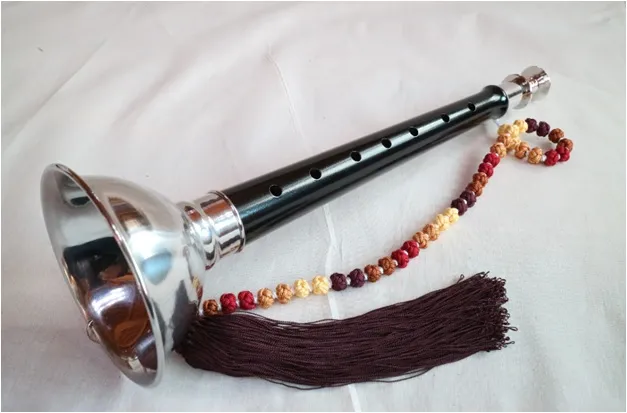Taepyeongso
Woodwinds
Asia
Between 0 and 1000 AD
Video
The taepyeongso is a traditional Korean double-reed wind instrument known for its loud, piercing sound and distinctive construction. It plays a significant role in various musical contexts, particularly in folk music, military ceremonies, and cultural festivals.
Description and Purpose
The taepyeongso features a conical wooden body, typically made from hardwoods such as cherry or pear wood. It is equipped with a large double reed that produces a sharp, vibrant tone. The instrument usually has seven finger holes on the front and one thumb hole on the back, allowing musicians to control pitch effectively. At the lower end of the taepyeongso is a metal bell that amplifies and brightens its sound, making it suitable for outdoor performances.
The primary purpose of the taepyeongso is to provide melodic lines in various musical settings. It is often used in traditional Korean music genres, particularly during outdoor festivals, military music, and ceremonial events. Its powerful sound allows it to cut through ambient noise, making it an ideal choice for leading ensembles and signaling important moments during celebrations.
History and Origin
The history of the taepyeongso dates back to the Goryeo Dynasty (918–1392), where it was utilized in both royal and military music. The instrument was commonly played during royal processions and outdoor festivals to mark significant events. During the Joseon Dynasty (1392–1910), the taepyeongso became a key instrument in Korean folk music and was widely used in traditional rituals and performances. It is believed to have originated from similar instruments in neighboring regions, possibly descending from the Persian saenap or the Chinese suona. Its introduction to Korea is thought to have occurred during the third to fifth centuries, as indicated by historical texts. Over time, it evolved into a prominent instrument within Korean culture, maintaining its relevance in both traditional and contemporary music.
Working Mechanism
The working mechanism of the taepyeongso involves air being blown into the mouthpiece, where a large double reed is positioned. When air passes through the reed, it vibrates against itself, producing sound waves that resonate through the conical body of the instrument. Players can manipulate pitch by covering or uncovering finger holes along the body. The conical bore design enhances sound amplification, allowing for a wide dynamic range from soft tones to powerful blasts.
Types of Taepyeongso
The taepyeongso (태평소) has evolved, and its modern form can differ from older variants. Here are the types and features of this traditional Korean wind instrument:
Traditional Taepyeongso (Gugak Version)
The classical version of the taepyeongso is used primarily in gukak (traditional Korean music). It has a double reed mouthpiece similar to that of an oboe, producing a bright, penetrating sound. It was typically made of wood (often a type of bamboo or mulberry) and could have a straight or slightly curved body.
Modern Taepyeongso (Pungnyu Ensemble Version)
Modern versions of the taepyeongso are slightly updated for performance in contemporary settings, such as festivals and theatrical performances. These instruments may be larger and more refined in design but retain the characteristic double-reed mouthpiece and overall shape. Modern versions may use materials like plastic or synthetic reeds in some cases, though traditional wood and reed materials are still commonly used.
Features
The taepyeongso is distinguished by several key features:
Construction Material: Traditionally made from hardwoods like cherry or pear wood, which contribute to its tonal quality.
Metal Bell: The addition of a metal bell at the lower end enhances projection and brightness of sound.
Dynamic Range: Capable of producing loud, bright tones that can easily be heard over large ensembles or outdoor noise.
Cultural Significance: The instrument plays an essential role in various Korean musical traditions and ceremonies, symbolizing cultural heritage.
It is a vital instrument in Korean music with deep historical roots and significant cultural importance. Its unique sound and versatility ensure its continued relevance in both traditional performances and modern musical expressions.
FAQ
What is the Taepyeongso and its Historical Significance?
The Taepyeongso is a traditional Korean double-reed wind instrument, often associated with military and ceremonial music. It has origins that trace back to the Goryeo period (918–1392) and is believed to be related to the Chinese suona. Historically, it was used in military camps and agricultural festivals, symbolizing authority and celebration in Korean culture.
How is the Taepyeongso Constructed?
The Taepyeongso features a conical wooden body, typically made from hardwoods such as jujube or citron. It has seven finger holes and one thumb hole for pitch control, along with a metal bell at the lower end that amplifies its sound. The instrument uses a large double reed inserted into a metal mouthpiece, which contributes to its loud and penetrating tone.
What Role Does the Taepyeongso Play in Modern Korean Music?
In modern Korean music, the Taepyeongso is commonly used in folk ensembles, military bands, and during traditional festivals. Its powerful sound makes it ideal for outdoor performances, and it is often featured in contemporary fusion music that blends traditional Korean elements with modern genres. The instrument continues to be celebrated for its vibrant and energetic contributions to Korean cultural expressions.
 Links
Links
References
Other Instrument
Categories


















